From the endless days of summer to the permanent darkness of the winter. The seasons of Svalbard explained.
Norway’s Arctic archipelago is a truly fascinating place whenever you visit. Yet the experience is wildly different depending on the time of year.
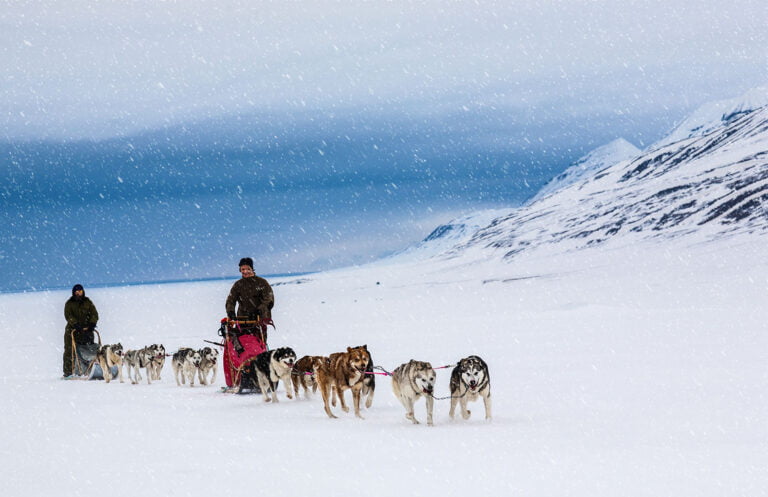
The unique Arctic environment and how drastically the polar latitude impacts the daylight play a significant role in travel to Svalbard.
So, anyone planning a trip should think carefully about what they want to do while in Svalbard to help decide the best time of year to travel. You can of course visit Svalbard at any time of year. But in this article, we take a look at the three main tourist seasons.
Polar Winter
October to February: Known locally as the mørketid, or “dark time,” Svalbard’s polar winter is a truly surreal experience.
During this season, the sun does not rise above the horizon at all—not even at midday. From mid-November to late January, the town of Longyearbyen is plunged into near-total darkness, with only a faint twilight at either end of the season.
Take a look at this video (below) to give you an idea of the conditions. This was taken at 1pm (yes, really) in early December:
Even so, this long night is not without beauty. The moon, stars, and sometimes the northern lights provide a glow unlike anything you’ll see elsewhere.
The snow-covered landscape reflects what little light there is, and the deep blue and purple hues of the sky create a hauntingly beautiful atmosphere. For many travellers, it’s the chance to experience something completely outside the ordinary.
Things to do in the Svalbard polar winter
The polar night makes Svalbard one of the few places on earth where you can see the northern lights in the middle of the day. That’s because the sky remains dark enough around the clock for aurora activity to be visible whenever conditions are right.
Northern lights tours are a highlight of this season. With little to no ambient light beyond the town itself, conditions for aurora viewing are ideal. A guided excursion offers the best chance to get away from light pollution and into the heart of the Arctic wilderness.
While outdoor activity is limited due to the dark and often bitter cold, you don’t need to spend all your time indoors.
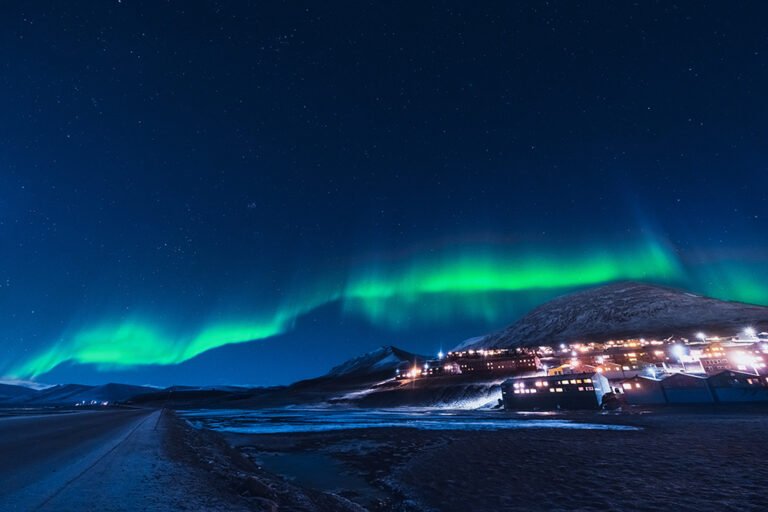
A snowcat tour is an accessible and atmospheric way to explore the area, while hearty travellers can join short hikes with headlamps or snowshoe excursions under the stars.
Indoors, there’s plenty to enjoy too. The Svalbard Museum offers a deep dive into the archipelago’s natural and cultural history, while the Svalbard Brewery provides a surprisingly cosy place to enjoy locally brewed Arctic beer, complete with stories of how they make beer in one of the world’s most remote settlements.
White Winter
Late February to April: As the sun returns to Svalbard after months of darkness, the landscape enters what many, including me, consider to be the best time of year to visit.
Known locally as the sun winter, this season offers a striking contrast to the polar night, with brilliant white snow under bright blue skies—all while temperatures remain firmly Arctic.
Daylight increases rapidly throughout this period. In early March, the sun hovers low on the horizon, creating long shadows and a magical golden glow. By late April, Svalbard enjoys 24-hour daylight as the midnight sun begins its reign.
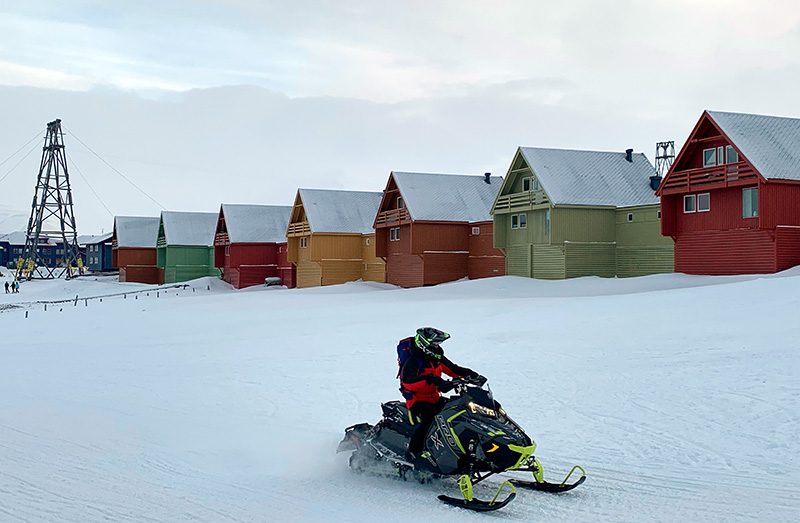
Don’t be fooled by the sunshine, though. Snow still blankets the ground, and sub-zero temperatures are the norm. You'll need proper winter clothing, especially for outdoor activities that take you beyond Longyearbyen.
Things to do in the Svalbard white winter
This is peak season for winter tourism in Svalbard. The stable weather, increased daylight, and deep snowpack make it the perfect time to explore beyond the settlements.
Snowmobile safaris are among the most popular excursions, taking visitors deep into the wilderness where you can experience the vastness and silence of the Arctic. Dog sledding is another unforgettable experience, with guided trips ranging from a couple of hours to multi-day adventures.
For photographers, the early part of the season offers a unique chance to capture blue hour—a deep, rich twilight that bathes the landscape in a soft, bluish glow. As the light intensifies through April and May, the white peaks and frozen fjords are revealed in full clarity.
While the northern lights are still visible in the first weeks of March, they fade as the days grow longer.
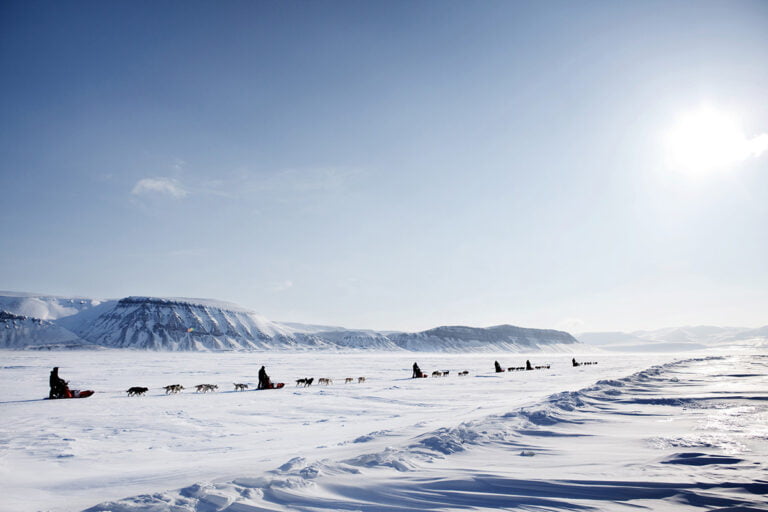
But in exchange, you gain the ability to experience Svalbard's wilderness in full daylight. It's often the only time of year when it's both bright and snowy.
Arctic Summer
Mid-May to August: As the midnight sun rises above the horizon and refuses to set, Svalbard enters its most accessible and outwardly welcoming season.
From late May through August, the archipelago is bathed in constant daylight, transforming the frozen landscape into one of colour, light, and life.
This is the season of movement and energy. Melting snow reveals rocky valleys and wild tundra. Migratory birds arrive by the thousands to nest. Wildlife becomes more visible, boats return to the fjords, and Longyearbyen hums with visitors and seasonal workers.
Although temperatures are milder than in winter, they remain unpredictable. While thermometers may occasionally hit double digits, you should still expect a chill in the air, especially in the evenings or out on the water. Layers remain essential. This is still the Arctic, after all.
Things to do in the Svalbard Arctic summer
The endless daylight and milder temperatures bring all manner of opportunities not available at other times of the year.
Wildlife spotting is a great example. Birds migrate to the Arctic archipelago in vast numbers to nest, drawn by the plentiful food on offer in the ocean. Walruses, seals and whales are also drawn into the fjords of Spitsbergen.
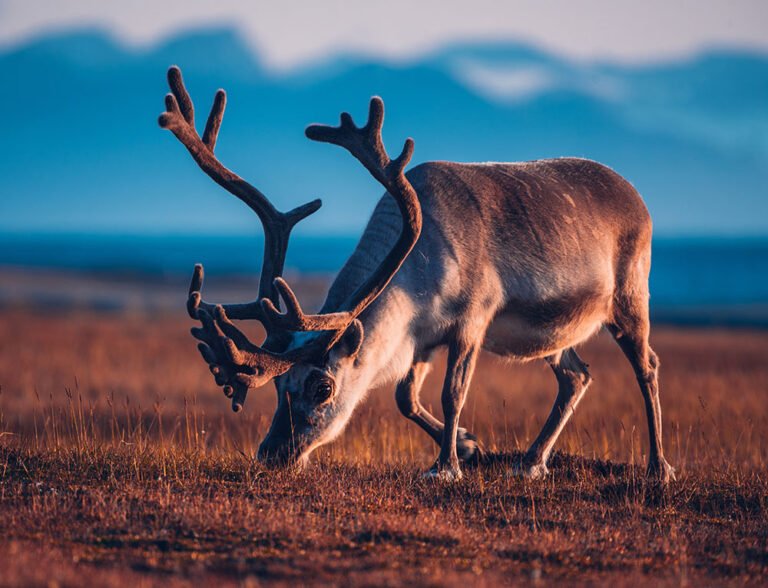
The summer is also the best time to see some of the species that call Svalbard their home year-round, including polar bears, polar foxes, Svalbard reindeer and the remarkable Svalbard rock ptarmigan.
At this time of year, boat trips are especially enjoyable. A diverse range of trips are on offer from wildlife and photography trips to pure sightseeing. Trips to the Russian settlements Barentsberg and Pyramiden are also popular.
The Arctic Autumn
September to early October: Often overlooked, autumn in Svalbard is a fleeting but fascinating time to visit. The days grow shorter, temperatures drop, and the landscape begins its transformation from Arctic summer into polar winter.
You won’t see the full return of darkness just yet, but the softening light and golden hues of the tundra create a unique atmosphere. It’s a time of change, for both nature and the people who live here, as Svalbard prepares to enter its long night.
Things to do in the Svalbard autumn
This is the quietest time of year in terms of tourism, meaning you’ll share the sights with very few others. Some summer boat tours and excursions continue into September, but availability becomes more limited as the season progresses.
It’s a good time for reflective travel. Photographers can capture Svalbard in a different light—literally—as the angle of the sun produces rich tones and long shadows across the mountains and valleys.
Wildlife sightings are still possible, especially reindeer and Arctic foxes, although migratory birds begin to disappear.
By early October, the first snow may arrive, and the darker evenings begin to hint at the polar night ahead.
Be aware that some businesses and tours may reduce their hours or close completely, so it’s essential to check availability in advance if you're travelling at this time of year.
When is your favourite time to visit Svalbard? Let me know in the comments. If you've enjoyed this post, why not share it on Pinterest, Twitter or Facebook? Just hit those social sharing buttons.



I would love to go on Polar nights.
My husband and I are both registered blind and have recently returned from a cruise that included a visit to Longyearbyen.
In all my 35 years of visiting Norway, never did I expect to reach so far north.
We had a truly amazing time. With grateful thanks to Audun and his colleague who run the one of Huskey Farm that accommodated our needs, we experienced dog sledding on wheeled sleds.
We left the port at 01:00 hours and, therefore, ahd the chance to experience midnight sun blazing onto our balcony.
This place is truly worth a visit.